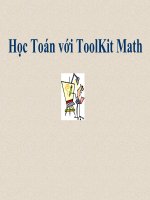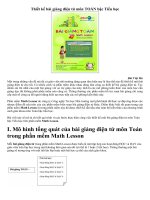- Trang chủ >>
- Sư phạm >>
- Sư phạm toán
Math Reviews
Bạn đang xem bản rút gọn của tài liệu. Xem và tải ngay bản đầy đủ của tài liệu tại đây (445.08 KB, 21 trang )
<span class='text_page_counter'>(1)</span>Mathematics for Economists. 1.
<span class='text_page_counter'>(2)</span> 2.1 Endogenous & Exogenous Variables; constants, parameters . TR – TC (identity) Qd = Qs (equilibrium condition) Y = a + bX0 (behavioral equation) Y: endogenous variable X0: exogenous variable a: constant b: parameter and the coefficient of exogenous variable X0 2.
<span class='text_page_counter'>(3)</span> 2.4 Functions and Relations. Function:. a set or ordered pairs with the property that for (x, y) any x value uniquely determines a single y value, e.g., curves or , e.g., mpp or cost curves Relation: ordered pairs with the property that for (x, y) any x value determines more than one value of y e.g., curves or ,. 3.
<span class='text_page_counter'>(4)</span> 2.4 General Functions Y. = f (X) Y is value or dependent variable (w/ range, vertical axis) f is the function or a rule for mapping X into a unique Y X is argument or the independent variable (w/ domain, horizontal axis) 4.
<span class='text_page_counter'>(5)</span> 2.5 Specific Functions Algebraic. Y Y Y Y Y Y. = = = = = =. functions. a0 (constant: fixed costs) a0+ a1 X (linear: S&D) a0 + a1X + a2X2 (quadratic: prod.) a0 + a1X + a2X2 + a3X3 (cubic: t. cost) a/X (hyperbolic: indiff.) aXb (power: prod. fn). Transcendental. functions (Ch. 10). Y = aX (exponential: interest) lnY = ln(a) + b ln(X) (logarithmic: easier) (Chiang & Wainwright, p. 22, Fig. 2.8) 5.
<span class='text_page_counter'>(6)</span> 2.5 Digression on exponents. Rules for exponents Xn = (X*X*X*...*X) n times Rule. I:. Xm * Xnm= Xm+n X. X m n. Rule. II:. Rule Rule. III: X = IV: X0 = 1. Rule Rule Rule. V: X1/n =nx VI: (Xm)n = Xmn VII:Xm * Ym = (XY)m. Xn -n. 1 Xn. 6.
<span class='text_page_counter'>(7)</span> 2.7 Levels of generality Specific. function 1: specific form and specific parameters Y = 10 - .5X. Specific. function 2: specific form and general parameters Y = a – bX. General. function: general form and no parameters Y = f(X) f maps X into a unique value of Y 7.
<span class='text_page_counter'>(8)</span> 3.1 Find the equilibrium price (P*) and quantity (Q*) Given. Qd. quantity demanded. Qs quantity supplied P price, where P* is the equilibrium price Assume Qd = Qs=Q* Qd a decreasing linear function of P Qs an increasing linear function of P P* > 0 One equilibrium and two behavioral equations 8.
<span class='text_page_counter'>(9)</span> 3.1 The meaning of equilibrium Qd a. Qs = - c + dP (supply). Qd Qs Q *. P ,Q *. *. Qd a bP P. O. -c. (demand). P*. ceterus paribus. Equilibrium:. a set of selected interrelated variables, e.g. P, Q, within the model adjusted to a state such that there no inherent tendency to change.. 9.
<span class='text_page_counter'>(10)</span> 3.1 Ingredients of a mathematical model A. mathematical economic model will consist of: ◦ ◦. Variables, Parameters,. Example:. Constants Equations and Identities. Supply-demand model. Qd = a - bP demand equation Qs = -c + dP supply equation Qd = Qs= Q* equilibrium condition. 10.
<span class='text_page_counter'>(11)</span> 3.2 Solving a linear market model Partial. equilibrium model of supply & demand 1) Qd = Qs=Q* equilibrium condition 2) a – bP = -c + dP 3) (a + c) – (b+d)P* = 0 where P=P* when Q=0 4) (a + c) – (b+d)P = Q more general form linear formulae 5) P* = (a+c)/(b+d) 6) Q* = (ad-bc)/(b+d) 11.
<span class='text_page_counter'>(12)</span> 3.2 Solving a Linear Market Model Partial. equilibrium model of supply & demand Qd = Qs =Q* equilibrium condition Qd = 21 - 2P ; a=21, b=2 Qs = -4+ 8P ; c=4, d=8. linear formula P* = (a+c)/(b+d) = (21+4)/(2+8)=25/10=2.5 Q* = (ad-bc)/(b+d) = (21)(8)-(2)(4)/10 = 160/10 = 16 12.
<span class='text_page_counter'>(13)</span> Root of a Linear Market Model Let a 21, b 2, c 4, d 8 Qd a bP (blue) Qs c dP (black) Qd Qs Q * a bP c dP (a c) (b d ) P * 0 (a c) (b d ) P Q. (root) (function, red) 13.
<span class='text_page_counter'>(14)</span> 3.3a Quadratic Market Model 1) Qd = 4 – P2 demand equation 2) Qs = -1 + 4P supply equation 3) Qd = Qs = Q* equilibrium equation 4) 4 - P2 = -1 + 4P 5) P*2 + 4P* -5 = 0 root 6) P2 + 4P -5 = Q function How. do you solve for P*? ◦ Graphically? ◦ Factor? ◦ Quadratic formula? 14.
<span class='text_page_counter'>(15)</span> 3.3 eq.(3.6) Roots of a quadratic model. Qd 4 P 2 (black) Qs 1 4 P (blue) Qd Qs Q * 4 P 2 1 4 P. P 2 4 P 5 Q (red) P *2 4 P * 5 0. P. *. . . 5 P * 1 0. P * 5,. 1. Q * 21,. 3 15.
<span class='text_page_counter'>(16)</span> 3.3b Deriving the Quadric formula Take. ax2 + bx + c = 0, solve for x in terms a, b, c x2 + bx/a + c/a = 0 x2 + bx/a + b2/4a2 = b2/4a2 - c/a (x + b/2a)2 = (b2-4ac)/4a2 x + b/2a = (b2-4ac)½/2a x = (-b (b2-4ac)½)/2a quadratic formula Solve the system of eq. for P and set P = 0 by moving all terms to one side, then apply quadratic formula.. 16.
<span class='text_page_counter'>(17)</span> 3.3b Solving a Quadratic Market Model Using the Quadratic Formula ax2. + bx + c = 0 P*2 + 4P* -5 = 0. . 2. b b 4ac P 2a *. . 1. 2. 4 16 (4)(1)( 5) 2 1. 4 16 20 P 2 *. 1/ 2. 1. 2. 4 6 1, 5 2. 17.
<span class='text_page_counter'>(18)</span> Cubic formula: take ax3+bx2 +cx+d= 0 solve for x in terms of a, b, c, d 18.
<span class='text_page_counter'>(19)</span> Finding the roots of a cubic function Find the rational roots of the following cubic equation 3 3 1 x 3 x 2 x 0 4 8 8 8 x 3 6 x 2 3 x 1 0 x c (1,1 8,1 4 ,1 2) let c 1 8. 6 3 1 8 2 1 1 8 2 1 0 8 x 2 2 x 1 0 2 4 8 2 4 2. ( 8). 8 x 2 4 x 2 x 1 0 4 x 2 x 1 1 2 x 1 0 4 x 1 2 x 1 0 x 1 4 x 1 2 x 1 0 x 1, 1 4,1 2 19.
<span class='text_page_counter'>(20)</span> 3.4 Two-commodity market model Qd 1 Qs1 0 Q d 2 Q s 2 0 Qd 1 a 0 a1 P1 a 2 P2 Qs1 b0 b1 P1 b2 P2 Qd 2 0 1 P1 2 P2 Qs 2 0 1 P1 2 P2. 20.
<span class='text_page_counter'>(21)</span> Summary Elimination. of variable method is ok for v. simple models only, e.g., three linear or two linear and one quadratic equation models Complexity increases geometrically w/ increase in # equations, e.g., six eq. Linear model Need a better way to handle the nequation linear models -> matrix algebra! 21.
<span class='text_page_counter'>(22)</span>









